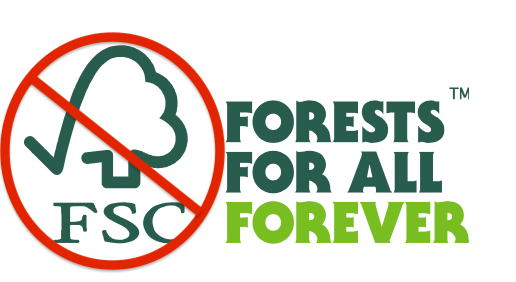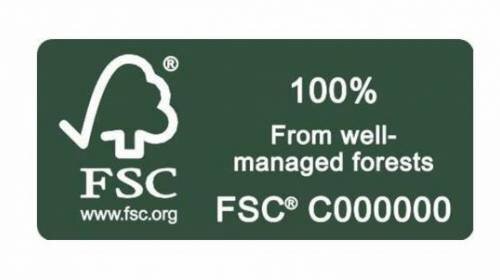Two years ago, I wrote about the perils of FSC certification of National Forest System lands in a Public Lands Blog post entitled “Certified Wood from National Forests? No. Make That Hell No! I encouraged the Forest Stewardship Council (FSC)—an organization I mostly admire—to abandon its effort to certify wood from national forest lands.
Now the FSC is back with a new document signaling its continuing quest to certify wood products that come from federal public lands (including units of the National Park System) as being “environmentally sound, socially beneficial, and economically prosperous.” The standards FSC is proposing to apply to federal forestlands are little more than what is required of federal land management agencies now, if that. It’s called greenwashing.
So far, I have happily recommended FSC-certified tree flesh to those who have asked (and commended it to those who haven’t). However, if any federal forestlands are certified by the FSC, I will no longer be able to recommend FSC-certified wood as I cannot be assured that the FSC label means the wood product didn’t come from the logging of older (mature and old-growth) forests on federal public forest lands. You, dear reader, have an opportunity to steer the FSC away from this outcome by commenting on the new document by June 14, 2021.
A Brief Recap of the FSC Certification Effort Two Years Ago
Here are the take-home messages from my April 2019 post:
• FSC certification of private lands is generally a good thing. In a nod of approval, I framed my house with FSC-certified wood.
• Of the three wood certification schemes, the FSC is far superior to the Sustainable Forestry Initiative (SFI) or the American Tree Farm System (ATFS).
• Because the FSC has standards superior to the SFI’s (the ATFS is a dead system walking), landowners find it easier and less costly to go with SFI rather than FSC certification.
• A major reason the FSC wants to certify wood coming from federal forests is to gain market share.
• National Forest System lands should not be lumped in with private timberlands.
• A few public lands conservation organizations support FSC certification of National Forest System lands, but the vast majority do not.
• FSC-certified wood from national forests would be a terrible thing.
The FSC should stand down from national forest wood certification because
• it would create brand damage;
• it would be of little interest to the Forest Service;
• it would create dissension in the conservation and sustainability communities;
• it would attract opposition from the conservation community; and
• having to deal with citizens unhappy with greenwashing of wood from national forests would soon consume most of the FSC’s resources.
The FSC’s Latest Gambit
The focus of the FSC certification effort I opposed earlier was the National Forest System. Now the FSC proposes to add Bureau of Land Management (BLM) public forest lands (mostly in western Oregon) to the mix.
The FSC-US is now in a “public consultation” phase regarding its proposed new rules for federal forestland certification, outlined in a 139-page document that I can only characterize as verbose, bureaucratic, and stupefying. (Fortunately, the pages have large type and wide margins.) Click at your own risk: “National Forest Stewardship Standard, Draft 1.0-v2-2020, Principles 1–10 Federal Lands Supplementary Requirements including Annex A: Glossary.”
Figure 2. If any federal forestlands are FSC certified, this label could mean that the wood came from older (mature and old-growth) forests on federal public lands. Source: Forest Stewardship Council-US.
This latest gambit still makes me wonder: Who needs the headaches?
• Not the FSC. If any federal forestland is FSC-certified, it becomes another avenue of complaint by citizens upset by federal forest mismanagement.
• Not the independent certifier (approved by the FSC) who would certify and monitor the units of federal forestlands—unless this outfit is getting paid by the hour.
• Not the federal forestland management bureaucracy, which would have to generate a lot more paperwork so as to be held further accountable. It already loathes being held to account by Congress, the administration (sometimes), the courts, and the public. Certification would cost on the order of several hundred thousand dollars per federal forest unit. Such certification would be a major significant action affecting the human environment, so a full environmental impact statement process would be required.
• Not private timberland owners who are already FSC certified, as certification of federal forest lands would cheapen the FSC label.
Fundamental Issues: Older Forests and Plantations
While the proposed certification standards cover many subjects, let’s focus on two close to the heart of any card-carrying conservationist:
• The conservation of older (mature and old-growth) forests.
The proposed standard calls for the protection of “Type 1” (never touched) and “Type 2” (remnant) “old growth” (not mature) forest. Type 1 protections only apply to stands > 3 acres, and Type 2 to stands > 20 acres. Individual old-growth trees could still be protected as “legacy trees,” but that would be totally subject to the discretion of the federal forest agency. To make matters worse, the draft federal lands indicators would insert a new requirement, saying that Type 1 and 2 are protected where considered “likely” to occur. Leaving the determination of what is “likely” to the federal forest agencies is an open invitation to abuse their discretion.
In addition, this consultation draft removed language that had been recommended to protect “late successional (mature and old-growth forest) stands on federal lands, and grow new ones to their historical levels. It has been replaced by language just requiring a slight net increase in late-successional stands.
• The prevention of new and the ecological restoration of existing plantations.
A Douglas-fir monoculture planation with trees all of the same species, heights, and diameters is ecologically more akin to a cornfield than a forest. There are millions of acres of these ecological abominations on federal public forestlands. Rather than require that plantations be put on a track toward ecological and hydrological restoration, he proposed FSC-US standard would generally bless the existing abominations and allow even more.
Reach Out to the Board and FSC-US Members
The twelve-person board of directors of the FSC-US is divided into three “chambers”: economic, environmental, and social. To set policy, a majority of the four members of each chamber must agree. According to the FSC website, the environmental chamber currently consists of
• Brent Davies, co-chair and treasurer; vice president, forests and ecosystem services, Ecotrust
• Linda Walker, senior director, corporate engagement, forests, World Wildlife Fund–US
• Stuart Hale, forest program manager, American Forest Carbon Initiative, The Nature Conservancy
(There is currently one vacancy, as Tracy Stone-Manning, formerly vice president for forests and ecosystem services at the National Wildlife Federation, has recently resigned as she has been tapped by the Biden administration to become the national director of the BLM [great!].)
If one clicks on the board member links above, you can send a personal email to the three environmental chamber representatives. I have done so with a cover note that is followed by this Public Lands Blog post. I will also be formally commenting via the FSC-US consultation portal before the 14 June 2021 deadline.
Below is a listing of the current members of the FSC-US of the environmental chamber.
• Ashbaugh, Charlie, Mr.
• Bramble, Barbara, Ms.
• Cork Forest Conservation Alliance
• Dogwood Alliance
• Dovetail Partners, Inc
• Ecotrust
• Greenpeace USA
• Guanacaste Dry Forest Conservation Fund
• Guillén, Abraham, Mr.
• Hall, Daniel A., Mr.
• Manomet, Inc (Manomet Center for Conservation Sciences)
• National Wildlife Federation
• Natural Resources Defense Council
• Northwest Natural Resource Group
• Pacific Forest Trust
• Rainforest Action Network
• Rainforest Alliance
• Sierra Club
• The Nature Conservancy
• Verra
• Washington Environmental Council
• Wildlife Conservation Society
• World Wildlife Fund USA
If you have a relationship with any of these organizations, you may want to reach out to them directly and urge them to oppose FSC-US certification of federal public lands and to resign if the organization proceeds.
The FSC-US membership list also shows 38 members of the economics chamber and the 21 members of the social chamber. Of the latter, notable “social” members of the FSC-US include Forest Stewards Guild, Green Mountain Club, Northwest Forest Worker Center, Sustainable Northwest, and The Trust to Conserve Northeast Forestlands (many social members are individuals).
Figure 3. If any federal forestlands are FSC certified, this label could mean that some of the wood came from older (mature and old-growth) forests on federal public lands. Source: Forest Stewardship Council-US
.
My Recommendation
The deadline for comments on the standards draft is June 14, 2021. Joint comments are going to be submitted separately by numerous organizations interested in public land conservation and restoration, and ecosystem-based carbon sequestration and storage (including The Larch Company). If your organization would like to sign on, email me and I’ll send you the link to the letter and sign-on process when it’s available.
Otherwise, or in addition, please send your own comment to the FSC. You can cut and paste from my thoughts below and/or pen your own thoughts.
• Certifying federal public forestlands would merely be greenwashing. As drafted, the proposed FSC standards generally require nothing more than what the Forest Service and the Bureau of Land Management are required to do by congressional statute, federal regulations, agency manuals, and land and resource management plans.
• The only logs coming out of federal forests should be by-products of scientifically sound ecological restoration, especially projects that reintroduce structural, species, and functional diversity to millions of acres of monoculture plantations.
• The highest and best uses of US federal public forestlands are the conservation and restoration of biological diversity, carbon storage and sequestration, watershed protection and restoration, and compatible recreation.
• Giving equal consideration to economic, environmental, and social values for federal public forestlands is not appropriate. Economics should not be a factor guiding the proper management of federal forests. Making it so would be like requiring the Smithsonian Institution, the National Park System, or the Department of Defense to turn a profit.
• If the FSC certifies any wood products that come from older (mature or old-growth) forests on federal public lands, it will greatly degrade the FSC label.


